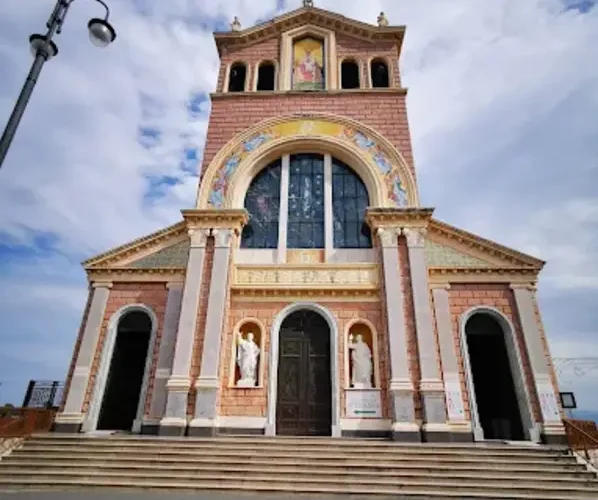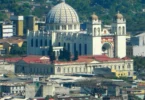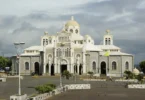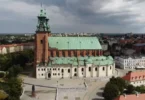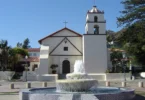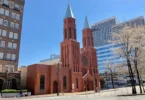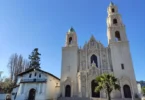Introduction
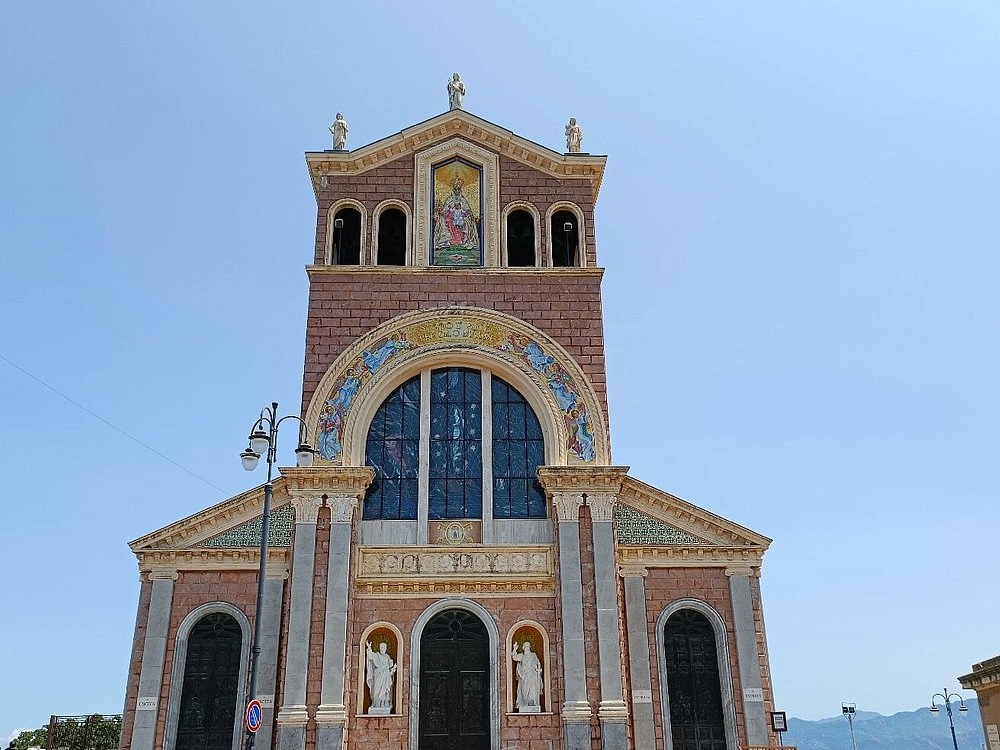
The Basilica Sanctuary of Maria Santissima del Tindari, also known as the Sanctuary of Tindari, the Sanctuary of the Black Madonna, or the Primitive Cathedral of Tindari, is a renowned Catholic pilgrimage site located in the picturesque hamlet of Tindari, within the municipality of Patti, in the metropolitan city of Messina, Sicily. Perched atop the hill of Tindari, the sanctuary offers breathtaking views of the surrounding landscape, including the serene Marinello Lakes, which lie within the protected Marinello Nature Reserve. This sacred site is historically significant as it occupies the location of the ancient fortress or castle of Tindari, a stronghold mentioned in historical records. Evidence of the fortress’s past can be seen in the remains of battlements and defensive structures found in the foundations of earlier religious buildings on the site. These remnants reinforce the belief that the original churches were built within or upon the remains of a fortified structure, symbolizing the blending of religious and military history in the region. On September 8, 2018, the sanctuary was elevated to the rank of a minor basilica by Pope Francis, recognizing its importance as a place of worship and pilgrimage, as well as its historical and cultural value. This honor further solidified its status as a prominent destination for the faithful, drawing visitors from all over the world to venerate the Black Madonna and experience the rich spiritual heritage of the sanctuary.
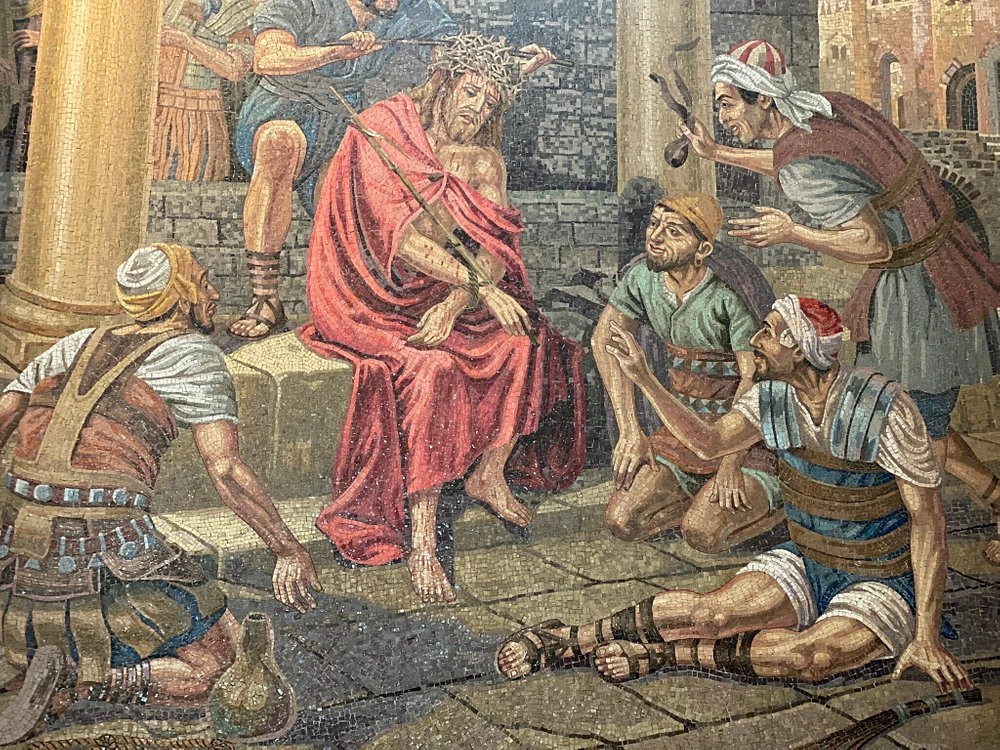
Origins and Greek Foundation
The Acropolis and Strategic Location
The acropolis of Tindari (Greek: Τύνδαρις, Týndaris) occupies the summit of a group of interconnected fortresses. The archaeological zone, representing the ancient Greek colony, is positioned on a flat, east-west stretch of land along the so-called “imperial road,” overlooking the Gulf of Patti. The site commands a strategic view extending north toward the Aeolian Islands, east to the Milazzo peninsula, and south to the Peloritani mountain range.
Founding of the Colony
In 396 BC, Dionysius the Elder, tyrant of Syracuse, founded Tyndaris as a colony for Spartan refugees following the Peloponnesian War (ended in 404 BC). The settlers included Locrians, Messenians, and Medmeans, Greek mercenaries linked to Aristotle and originally allied with the tyrants of Syracuse. The territory was granted to them as compensation for unpaid wages and loss of leadership. The settlers, known as Tyndarids, were especially devoted to the Dioscuri—Castor and Pollux, mythological sons of Jupiter and Leda, wife of King Tyndareus of Sparta. The city’s name, Tyndaris, derives from this mythological lineage.
Urban Structure of Ancient Tindari
The ancient urban core of Tindari was a bustling and strategically designed settlement that showcased the fusion of Greek and Roman influences. The city was surrounded by city walls, providing protection while reflecting the strategic importance of the area. At the heart of the city stood the Greek-Roman theatre, a prominent feature where performances and gatherings took place. The basilica served as a key public building, playing an important role in the civic and religious life of the city. The area also contained imperial domus, which were grand residences and shops, highlighting the city’s wealth and active commercial life. To enhance daily life, the residents enjoyed the thermae, or baths, which were both places of relaxation and socializing. The floors of many buildings were adorned with intricate mosaics, demonstrating the artistic skill of the time. Today, the archaeological museum in Tindari preserves and displays artifacts from this rich urban history, offering insight into the daily life, culture, and grandeur of ancient Tindari.
Christianization and the Diocese of Tindari
Byzantine Period and Early Christianity
From 535 to 836, Tindari served as an episcopal seat under the Byzantine Empire, forming the Diocese of Tindari (Dioecesis Tyndaritana). The cathedral was built over the ruins of a temple to Ceres. In the late 6th century, Pope Gregory the Great mentioned bishops Eutichius and Benenato, among others, in correspondence.
Islamic Conquest and Suppression
In 836–837, the Aghlabid army under al-Fadl ibn Yaʿqūb and Abū l-Aghlab Ibrāhīm conquered Tindari. The diocese was suppressed, and Tindari became absorbed into the Diocese of Messina. Continuous pirate raids led the episcopal court to take refuge in Troina. In 886, the Metropolitan of Syracuse, Theodore, referred to the “Diva Virgo in Castello Tyndaritano”, indicating ongoing Marian devotion at the site.
Norman Period and Medieval Religious Foundations
During the Norman period, Tindari and its surrounding region experienced significant religious and architectural development. In 1110, the Monastery of Sant’Elia di Scala, following the Greek Rite, was established near the ruins of ancient Tindari. Around the same time, the Church of the Holy Mother of God, also known as Santa Maria de lo Plano, was founded in Oliveri, functioning as a dependency of the Monastery of Santa Maria di Gala in Barcellona Pozzo di Gotto. By 1178, Roger II of Sicily had commissioned the Church of San Giovanni in Oliveri, further strengthening the area’s ecclesiastical presence. In parallel, the region was fortified. The Castle of Adelasia di Patti, constructed in the 12th century atop a former Neolithic necropolis, was rebuilt by Adelasia del Vasto, the influential Norman noblewoman and mother of Roger II. Liviri Castle in Oliveri was another important fortification, built by Count Roger himself. Between 1105 and 1148, monastic institutions received significant support through royal grants. These included the medieval tuna fishery of Oliveri, and water mills in Furnari (granted by Queen Adelasia) and Patti (granted by Queen Margaret of Navarre).
Later Medieval and Early Modern Period
Feudal and Royal Administration
During the 14th and 15th centuries, Tindari was consistently referred to as a castrum, or fortified settlement, signifying its continued military and strategic importance. The control of the fortress and its surrounding lands shifted through royal grants to prominent noble families. Among the key figures were Boniface of Aragon, a cousin of King Peter II of Sicily, and Vinciguerra of Aragon, Baron of Militello, who received extended control of the region during the reign of Frederick IV of Sicily. Their stewardship marked a phase of feudal consolidation and defensive oversight in the area.
Military Threats and Corsair Raids
Between 1502 and 1544, the coastal towns of northern Sicily, including Tindari, endured devastating raids by the famed Ottoman corsairs Khayr al-Din Barbarossa, Aruj Barbarossa, and Rais Dragut. These attacks were part of the broader geopolitical struggle between the Ottoman Empire and Spanish-controlled Sicily for dominance in the Mediterranean. Tindari’s church-fortress was sacked, and the Cathedral of San Bartolomeo in Patti was set ablaze. The island of Lipari was captured and plundered, while Milazzo and Santa Lucia del Mela faced imminent threats. These persistent assaults culminated in the major naval clash at the Battle of Lepanto in 1571, where the Ottoman advance in the western Mediterranean was decisively checked by the Holy League.
The Sanctuary of the Black Madonna of Tindari
Reconstruction and Historical Records
Between 1552 and 1598, a new sanctuary dedicated to the Black Madonna was constructed atop the remnants of earlier religious structures, marking a significant phase in the spiritual and architectural history of Tindari. This rebuilding effort reinforced the sacred character of the site and accommodated the increasing number of pilgrims drawn by the growing cult of the Virgin. In 1558, the renowned Sicilian historian and theologian Tommaso Fazello documented the presence of the church of Santa Maria de Tindáro located at the summit of the fortress. His writings provided valuable insight into the continuity of Christian worship on the ancient acropolis. Later, in 1578, royal military architects Tiburzio Spannocchi and Camillo Camilliani recorded detailed observations of the sanctuary, notably describing it as a crenellated fortress, emphasizing its dual role as a place of worship and a defensive stronghold during a period marked by frequent coastal incursions.

The Icon of the Black Madonna of Tindari
The Black Madonna of Tindari is deeply rooted in local legend and religious devotion. According to tradition, the Byzantine statue was brought from the East to escape iconoclastic persecution. During a violent storm, the ship carrying the statue sought refuge in the bay of Tindari, near the Marinello Lakes. Strangely, the vessel could not resume its voyage until the statue was offloaded—an event interpreted as a divine sign that the Madonna wished to remain there. The statue was then carried up to the promontory and placed in a small church, which, over time, was expanded due to the influx of pilgrims drawn by the miraculous reputation of the figure. The statue itself is carved from Lebanese cedar wood, crafted in an oriental style that dates to the late 8th or early 9th century. It depicts the Virgin Mary as a Theotókos Odigitria—“Mother of God who shows the way”—seated with the Child Jesus on her lap. Jesus is shown raising his right hand in blessing, while the Madonna wears an eastern-style crown or turban, signifying her royal status as Basilissa. Beneath her throne is the inscription “Nigra Sum Sed Formosa” (“I am black but beautiful”), a line from the Song of Songs 1:5, which underscores both her physical appearance and spiritual beauty. The statue remains a powerful symbol of faith and resilience, blending Eastern Christian iconography with Western devotion.
Architecture of Basilica Shrine of Our Lady, Tindari, Italy
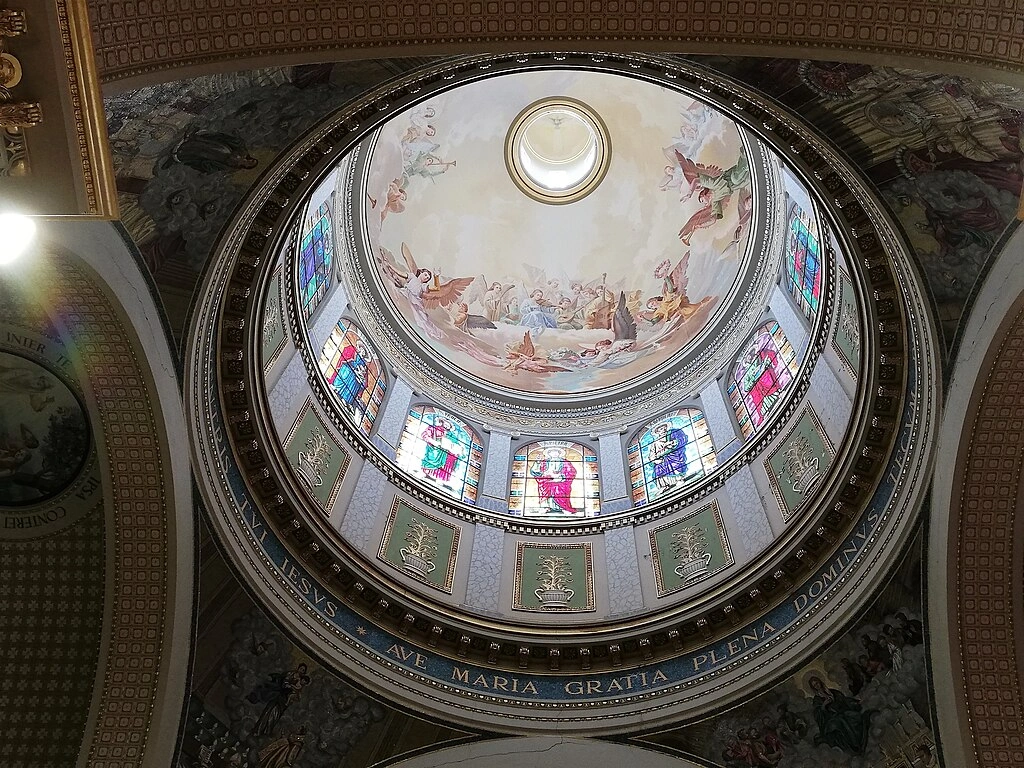
Architectural style: Baroque architecture
The Sanctuary of the Black Madonna of Tindari: Architecture and Religious Significance
The Sanctuary of the Black Madonna of Tindari has undergone multiple reconstructions and restorations, preserving its cultural and religious significance over centuries. Very few artefacts survived the devastating raids by the Arabs, and the church housing the icon, likely already relocated, also fell victim to destruction. Oral tradition holds that the icon of the Black Madonna was moved to Oliveri during the period when the city was under Byzantine control (535–836 AD), amid the rise of iconoclastic persecution under Emperor Leo III the Isaurian. In 1544, the sanctuary was partially destroyed during the sacking by Admiral Khayr al-Din Barbarossa and his successor Rais Dragut, who spared the revered statue of the Black Madonna but removed its bells. The rebuilding of the sanctuary began in 1552, when Bishop Bartolomeo Sebastiani of Patti led efforts to restore it, adding rooms to accommodate personnel dedicated to the worship of the Madonna. The sanctuary’s reconstruction was completed in 1598, with the year carved into the keystone of the entrance portal.
From 1890 to 1908, Bishop Giovanni Previtera further expanded the sanctuary, officially establishing it and overseeing major restorations to both the sanctuary and the Archbishop’s Palace. He also transformed the old Monastery of the Poor Clares into the modern Institute of the Holy Family, and his efforts extended to the founding of humanistic, religious, and professional schools. A Catholic bank was also founded to combat usury, and the bishop promoted Catholic media through the establishment of the Il Tindari newspaper.
Between 1925 and 1927, period photographs show the sanctuary as a fortified complex, with several votive chapels standing on the esplanade in front. This period further emphasized the sanctuary’s role as a center of pilgrimage and devotion.
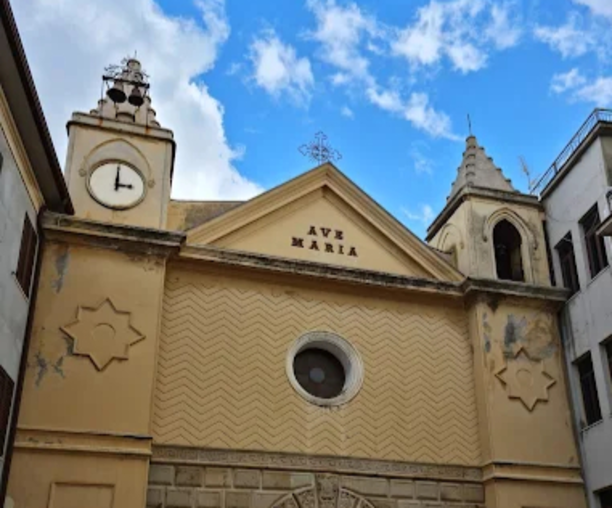
Sanctuary Facade and Architecture
The facade of the sanctuary is distinguished by a gabled elevation flanked by bell towers, creating a striking verticality. The portal’s arch is crafted from ashlar, and the first order of the external wall features intricate detailing. The second order is defined by a circular window above the entrance, while the third order is marked by a triangular tympanum bearing the dedication “AVE MARIA.” The bell towers are decorated with eight-pointed stars, crafted by layering staggered squares, and feature single-lancet windows and a clock face on the left tower. The towers’ square-based cusps close the fourth order, with the left tower being smaller and externally placed. The counter-façade above the portal is adorned with a painting depicting the processional procession, showing the community’s reverence as the icon is carried from the beach to the acropolis. Also visible is a painting of Saint Febronia, Patron Saint of Patti, ascending to heaven, created by Guglielmo Borremans. The Patron Saint’s title was established by Bishop Previtera.

The High Altar
The High Altar of the sanctuary is dedicated to the Sacred Heart of Jesus, and its design features a double pair of columns, with the inner columns projecting and topped by symmetrical, curled tympanums. At the center, a coat of arms is flanked by friezes and bears the inscription “VENITE FILII, AVDITE ME, TIMORE DOMINI, DOCEBO VOS”, which translates to “Come, children, listen to me; I will teach you the fear of the Lord.” While the altar initially hosted the Madonna’s icon, it now houses the statue of the Sacred Heart of Jesus, with a richly adorned silver tabernacle at its center. The sanctuary’s altar features one of the last rites performed ad orientem, before the construction of the modern altar versus populum (altar facing the people). The presbytery contains two large paintings, one depicting the veneration of the icon, and another showing the recovery of the icon by fishermen’s nets after it was moved from the chest.
Right Aisle
In the right aisle, the vault and niche display a statue of Saint Joseph holding the Baby Jesus. The Chapel of Maria Santissima del Tindari is dedicated to the Madonna of Tindari. This Baroque-style chapel is ornately decorated, with a high-relief stucco canopy supported by twisted columns. The central niche displays a reproduction of the icon of the Black Madonna, created by Salvatore Rizzuti in 1997. The chapel’s decorative elements, such as cherubs, a crowned coat of arms, and marble inlays, create a rich and visually impactful scene that evokes a sense of pilgrimage and reverence. The chapel is further adorned with cherub heads, seashell motifs symbolizing the earthly pilgrimage, and other symbolic imagery. On the left side of the aisle, an opening leads to a room with a window overlooking the lakes, where votive offerings cover the walls, testifying to the deep faith and gratitude of the pilgrims.
Left Aisle
The left aisle of the sanctuary features the dome of the new sanctuary, adorned with frescoes that enhance the sacred atmosphere. The aisle also houses a niche containing a marble statue of Jesus baptized by St. John the Baptist in the River Jordan. Additionally, the Choir Chapel is restored to resemble the original southern altar, with an ideal view facing the Tyrrhenian Sea.
Liberian Church Title
Both sanctuaries, including the one in Tindari, hold the title of “Liberian Church.” This designation traces its origins to the Basilica of Santa Maria Maggiore in Rome, the oldest Marian sanctuary in the West, built under the pontificate of Pope Liberius in the 4th century. The title is not universally proven by historical documents but is deeply rooted in the tradition of the early Church. These churches are also informally known as “ad Nives” or “of the Snow”, referencing a miraculous snowfall that is said to have occurred to mark the location of the basilica’s construction. An epigraphic text further attests to the sanctuary’s Liberian status: “DOM SACRO SANCTÆ BASILICÆ – LIBERIANÆ S(ANCTA) MARIÆ MAJORIS – ROMÆ PERPETVO AGGREGATVM HOC – VENERABLE SANCTVARIVM , QVOD – VISITATVM, – AC SI ILLA PERSONALI – VISITARETVR PARTICIPANS – OMNIA PRIVILEGIA, UT IN BVLLA – DATA ROMÆ – XIII MAII MDCCLIII” This inscription reflects the deep connection between the Tindari sanctuary and the venerable tradition of Liberian churches across the Christian world.
Modern Sanctuary of the Black Madonna of Tindari
The modern sanctuary of the Black Madonna of Tindari has a rich history of restoration and expansion, especially in the mid-20th century. Following significant events such as requisition by the Royal Italian Army and occupation by English soldiers during World War II, the sanctuary underwent a series of transformations to accommodate the growing number of pilgrims.
World War II and the Post-War Period
On 22 January 1943, the sanctuary’s structures were requisitioned by the Royal Italian Army, and the site was later occupied by English soldiers, who installed a military hospital within the sanctuary. After the war, the sanctuary faced further challenges, including the growing number of pilgrims, which made the existing church inadequate for the influx of worshippers.
Expansion and Reconstruction
From 1953 to 1977, it became clear that the existing sanctuary was no longer sufficient to meet the needs of pilgrims. Efforts to find a suitable solution led to the decision to construct a new building without compromising the integrity of the ancient church. The first stone for the new sanctuary was laid on December 8, 1957, following archaeological excavations. It was blessed by Pope Pius XII on December 30, 1956. On September 6, 1975, Monsignor Giuseppe Pullano blessed the interior of the new sanctuary, and the icon of the Madonna was brought to its new location, where it was placed on the monumental altar. The sanctuary was officially consecrated and dedicated on May 1, 1979, by Cardinal Salvatore Pappalardo, assisted by Bishop Carmelo Ferraro of Patti.
Elevation to Minor Basilica

Architectural Features
The modern sanctuary follows a basilica plan, designed in the shape of a Latin cross, featuring three naves, a square transept, and a semicircular apse. The church spans 64 meters in length and 24 meters in width. The base of the sanctuary is made of billiemi marble, while the roof is covered in blue ceramics. A prominent loggia, 76 meters long and 8 meters wide, is located on the northern side of the church, adjacent to the left nave, offering visitors a stunning view of the Marinello lakes. Below the loggia, a large room connects to the crypt, which serves as the sanctuary’s penitentiary.

Facade and Exterior
The facade of the sanctuary features a central, advanced body that rises over the square, facing west. The structure incorporates a bell tower. The doors are made of bronze, and beside the central door, statues of Saint Peter and Saint Paul are placed in special niches. Access to the sanctuary is through an atrium decorated with stained glass windows, which depict the cardinal virtues: Prudence, Justice, Fortitude, and Temperance. The theological virtues are depicted on the access gates, with each entrance symbolizing a different virtue: Faith on the left entrance, Charity at the central gate, and Hope on the right entrance.
Interior Features
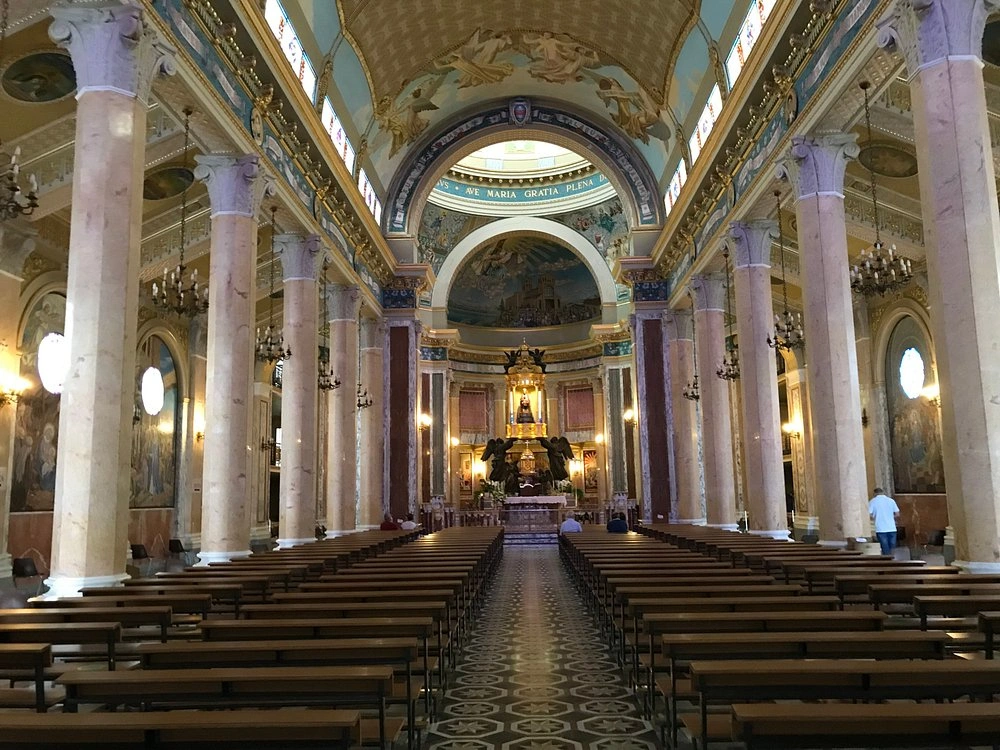
Saint Michael the Archangel stands proudly as a mosaic in the entrance arch, while the interior grandstand near the atrium houses a large pipe organ by the Fratelli Ruffatti company of Padua. In the central nave, octagonal columns with white marble bases define the space. A 75 m² canvas on the vault, painted by Fausto Conti, depicts The Triumph of the Madonna. At the top of the vault, angels hold scrolls with important phrases from the Magnificat: “MAGNIFICAT ANIMA MEA DOMINUM,” “BEATAM ME DICENT OMNES GENERATIONES,” and “QVIA FECIT MIHI MAGNA, QVI POTENS EST.” On the external walls of the side naves, large mosaics illustrate the Mysteries of the Rosary, based on the works of Fausto Conti. The stained glass windows showcase the allegory of Charity, surrounded by celestial angels.
The Altar and Apse
The altar and apse of the Sanctuary of the Black Madonna of Tindari are key features in its sacred design, blending artistic expression with deep spiritual significance. The large altar in the transept is supported by yellow marble jambs, with a white marble sculpture of the Last Supper placed beneath the altar table. Above it, under the dome, the Madonna del Tindari is enthroned. She rests on a prominent altar, surrounded by majestic bronze angels, whose dynamic poses and kneeling positions emphasize reverence and devotion. These angels hold the simulacrum of the Madonna within a crystal compass, creating a powerful visual focal point. The apse, with its grand semicircular colonnade, is adorned with mosaics that narrate key moments in the sanctuary’s history. These include the recovery of the Madonna’s icon after a shipwreck in the 9th century, the enthronement of the statue in a pagan temple, the Madonna surviving a pirate attack in 1544, the delivery of the keys by the jurors of Patti in 1669, and several coronations of the Virgin in the late 19th and early 20th centuries. These mosaics, alongside other elements in the sanctuary, create a profound spiritual atmosphere, connecting the faithful to the sanctuary’s rich history and the Madonna’s enduring protection.
Feast Day
Feast Day : 08 September
The Feast of the Madonna del Tindari is celebrated annually on September 8, coinciding with the Nativity of the Virgin Mary. The festivities begin on September 7 with a procession, followed by a Pontifical Mass on September 8. Pilgrims gather at the Basilica Shrine of Our Lady in Tindari to honor the Black Madonna, a statue believed to have arrived in the area in the 8th or 9th century. The sanctuary’s religious celebrations, including novenas and Eucharistic services, attract thousands of visitors each year.
Church Mass Timing
Monday to Saturday : 7:30 AM , 10:00 AM
Sunday : 7:30 AM , 9:00 AM , 10:30 AM , 12:00 PM
Church Opening Time:
Monday to Sunday : 6:45 am – 12:30 pm, 2:30 pm – 7:00 pm.
Contact Info
Address : Basilica of Our Lady of the Castle
Via Porta del Fiumicello, 87012 Castrovillari CS, Italy
Phone : +39 098 120 0456
Accommodations
Connectivities
Airway
Basilica Shrine of Our Lady, Tindari, Italy, to Campo di Volo di Capo d’Orlando Via Trazzera Marina, distance between 42 min (43.6 km) via A20/E90.
Railway
Basilica Shrine of Our Lady, Tindari, Italy, to Catania Orazio Via Santa Cecilia, distance 54 min (61.7 km) via A20/E90.

